PRINCIPLES OF ART MANAGEMENT
VerifiedAdded on 2022/10/19
|10
|2362
|425
AI Summary
PRINCIPLES OF ART MANAGEMENT PRINCIPLES OF ART MANAGEMENT 9 9 PRINCIPLES OF ART MANAGEMENT PRINCIPLES OF ART MANAGEMENT Name of the Student Name of the University Author Note Introduction 2 Discussion 2 Size and Context of Operation: 2 Audiences 4 Programming 5 Marketing Policies 5 Funding 7 Conclusion 7 Introduction Art and culture vary according to place and people. Discussion Size and Context of Operation: The Arts Centre Melbourne is popularly known as the Arts Centre. It can be deduced that the
Contribute Materials
Your contribution can guide someone’s learning journey. Share your
documents today.
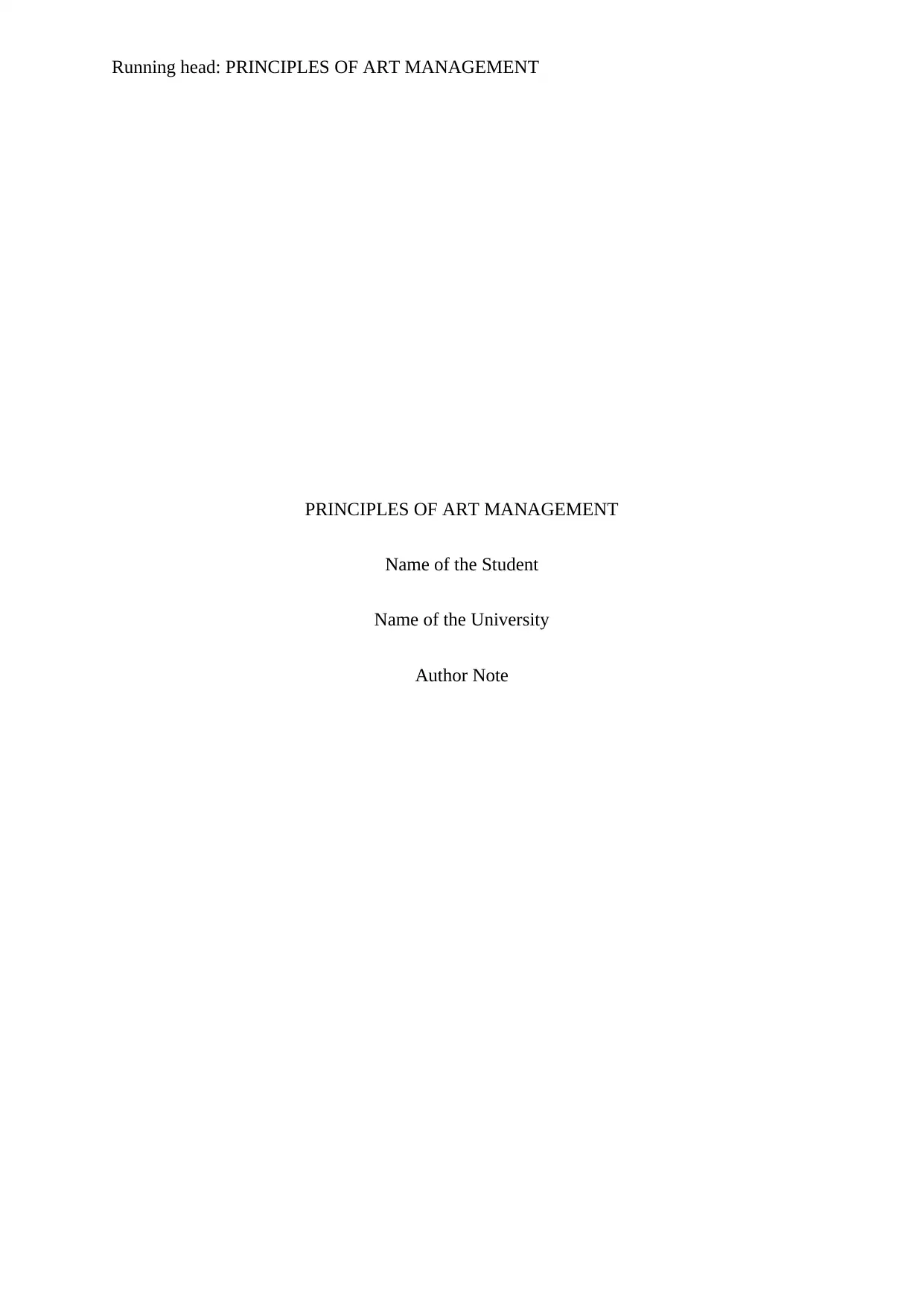
Running head: PRINCIPLES OF ART MANAGEMENT
PRINCIPLES OF ART MANAGEMENT
Name of the Student
Name of the University
Author Note
PRINCIPLES OF ART MANAGEMENT
Name of the Student
Name of the University
Author Note
Secure Best Marks with AI Grader
Need help grading? Try our AI Grader for instant feedback on your assignments.
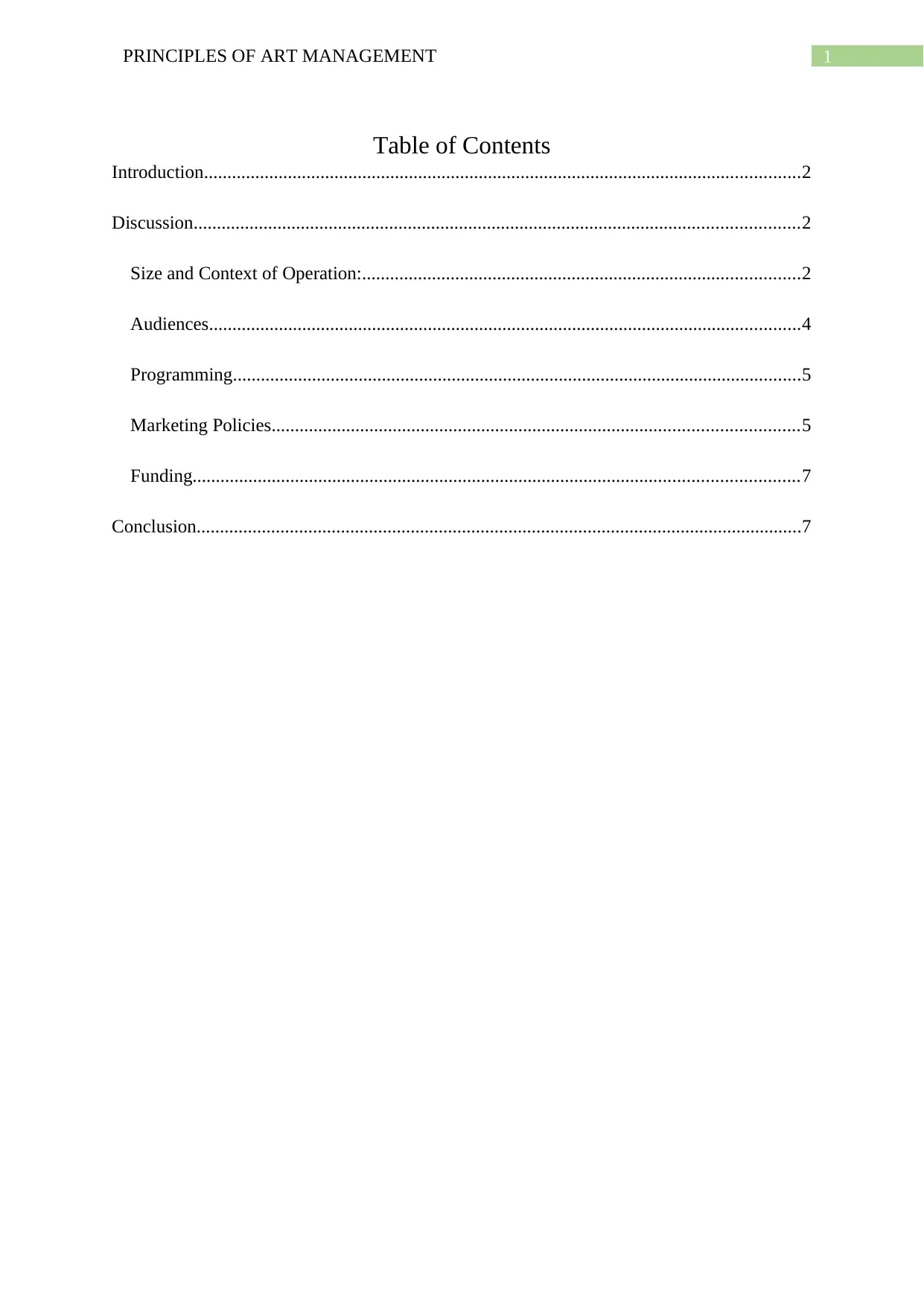
1PRINCIPLES OF ART MANAGEMENT
Table of Contents
Introduction................................................................................................................................2
Discussion..................................................................................................................................2
Size and Context of Operation:..............................................................................................2
Audiences...............................................................................................................................4
Programming..........................................................................................................................5
Marketing Policies.................................................................................................................5
Funding..................................................................................................................................7
Conclusion..................................................................................................................................7
Table of Contents
Introduction................................................................................................................................2
Discussion..................................................................................................................................2
Size and Context of Operation:..............................................................................................2
Audiences...............................................................................................................................4
Programming..........................................................................................................................5
Marketing Policies.................................................................................................................5
Funding..................................................................................................................................7
Conclusion..................................................................................................................................7
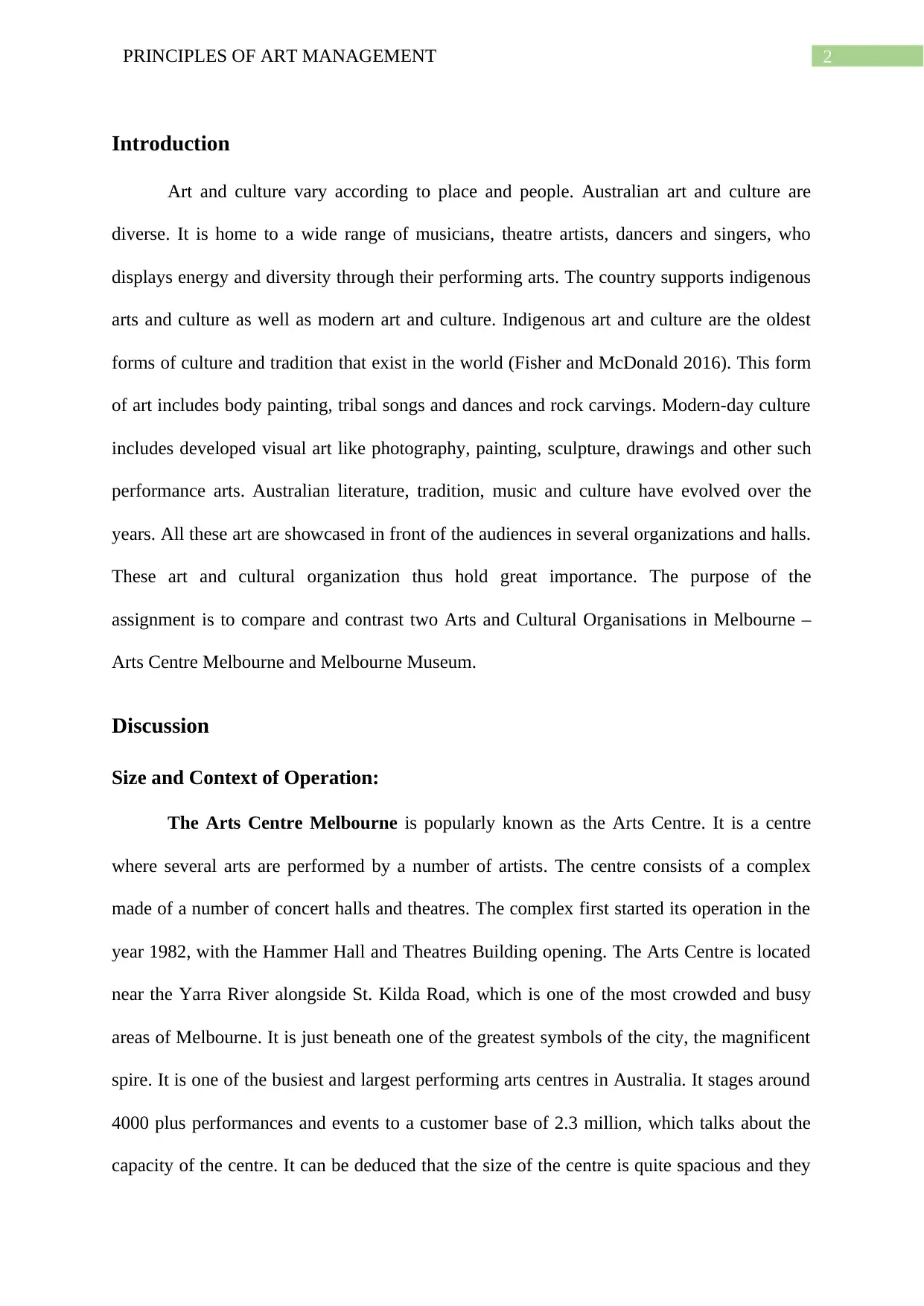
2PRINCIPLES OF ART MANAGEMENT
Introduction
Art and culture vary according to place and people. Australian art and culture are
diverse. It is home to a wide range of musicians, theatre artists, dancers and singers, who
displays energy and diversity through their performing arts. The country supports indigenous
arts and culture as well as modern art and culture. Indigenous art and culture are the oldest
forms of culture and tradition that exist in the world (Fisher and McDonald 2016). This form
of art includes body painting, tribal songs and dances and rock carvings. Modern-day culture
includes developed visual art like photography, painting, sculpture, drawings and other such
performance arts. Australian literature, tradition, music and culture have evolved over the
years. All these art are showcased in front of the audiences in several organizations and halls.
These art and cultural organization thus hold great importance. The purpose of the
assignment is to compare and contrast two Arts and Cultural Organisations in Melbourne –
Arts Centre Melbourne and Melbourne Museum.
Discussion
Size and Context of Operation:
The Arts Centre Melbourne is popularly known as the Arts Centre. It is a centre
where several arts are performed by a number of artists. The centre consists of a complex
made of a number of concert halls and theatres. The complex first started its operation in the
year 1982, with the Hammer Hall and Theatres Building opening. The Arts Centre is located
near the Yarra River alongside St. Kilda Road, which is one of the most crowded and busy
areas of Melbourne. It is just beneath one of the greatest symbols of the city, the magnificent
spire. It is one of the busiest and largest performing arts centres in Australia. It stages around
4000 plus performances and events to a customer base of 2.3 million, which talks about the
capacity of the centre. It can be deduced that the size of the centre is quite spacious and they
Introduction
Art and culture vary according to place and people. Australian art and culture are
diverse. It is home to a wide range of musicians, theatre artists, dancers and singers, who
displays energy and diversity through their performing arts. The country supports indigenous
arts and culture as well as modern art and culture. Indigenous art and culture are the oldest
forms of culture and tradition that exist in the world (Fisher and McDonald 2016). This form
of art includes body painting, tribal songs and dances and rock carvings. Modern-day culture
includes developed visual art like photography, painting, sculpture, drawings and other such
performance arts. Australian literature, tradition, music and culture have evolved over the
years. All these art are showcased in front of the audiences in several organizations and halls.
These art and cultural organization thus hold great importance. The purpose of the
assignment is to compare and contrast two Arts and Cultural Organisations in Melbourne –
Arts Centre Melbourne and Melbourne Museum.
Discussion
Size and Context of Operation:
The Arts Centre Melbourne is popularly known as the Arts Centre. It is a centre
where several arts are performed by a number of artists. The centre consists of a complex
made of a number of concert halls and theatres. The complex first started its operation in the
year 1982, with the Hammer Hall and Theatres Building opening. The Arts Centre is located
near the Yarra River alongside St. Kilda Road, which is one of the most crowded and busy
areas of Melbourne. It is just beneath one of the greatest symbols of the city, the magnificent
spire. It is one of the busiest and largest performing arts centres in Australia. It stages around
4000 plus performances and events to a customer base of 2.3 million, which talks about the
capacity of the centre. It can be deduced that the size of the centre is quite spacious and they
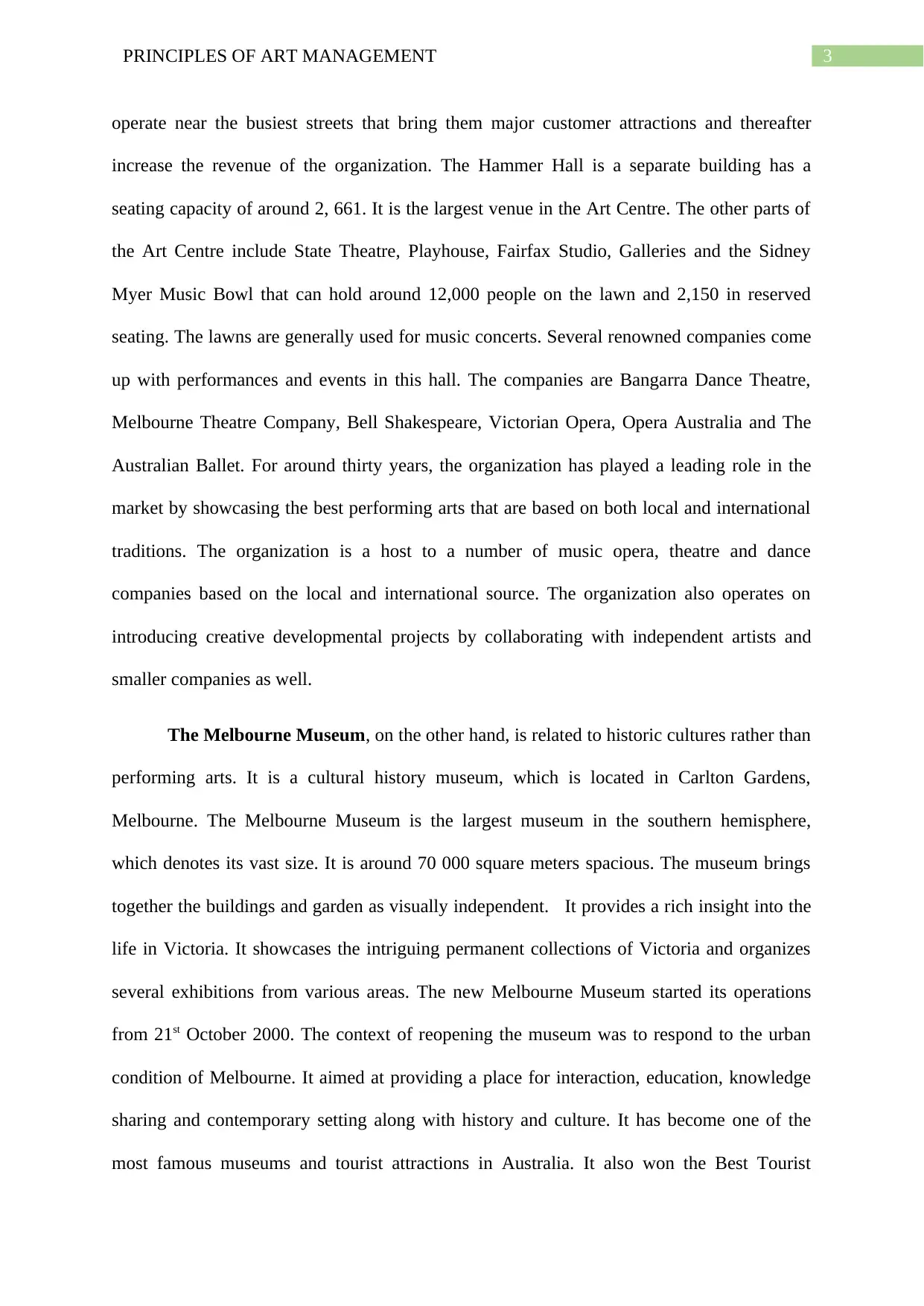
3PRINCIPLES OF ART MANAGEMENT
operate near the busiest streets that bring them major customer attractions and thereafter
increase the revenue of the organization. The Hammer Hall is a separate building has a
seating capacity of around 2, 661. It is the largest venue in the Art Centre. The other parts of
the Art Centre include State Theatre, Playhouse, Fairfax Studio, Galleries and the Sidney
Myer Music Bowl that can hold around 12,000 people on the lawn and 2,150 in reserved
seating. The lawns are generally used for music concerts. Several renowned companies come
up with performances and events in this hall. The companies are Bangarra Dance Theatre,
Melbourne Theatre Company, Bell Shakespeare, Victorian Opera, Opera Australia and The
Australian Ballet. For around thirty years, the organization has played a leading role in the
market by showcasing the best performing arts that are based on both local and international
traditions. The organization is a host to a number of music opera, theatre and dance
companies based on the local and international source. The organization also operates on
introducing creative developmental projects by collaborating with independent artists and
smaller companies as well.
The Melbourne Museum, on the other hand, is related to historic cultures rather than
performing arts. It is a cultural history museum, which is located in Carlton Gardens,
Melbourne. The Melbourne Museum is the largest museum in the southern hemisphere,
which denotes its vast size. It is around 70 000 square meters spacious. The museum brings
together the buildings and garden as visually independent. It provides a rich insight into the
life in Victoria. It showcases the intriguing permanent collections of Victoria and organizes
several exhibitions from various areas. The new Melbourne Museum started its operations
from 21st October 2000. The context of reopening the museum was to respond to the urban
condition of Melbourne. It aimed at providing a place for interaction, education, knowledge
sharing and contemporary setting along with history and culture. It has become one of the
most famous museums and tourist attractions in Australia. It also won the Best Tourist
operate near the busiest streets that bring them major customer attractions and thereafter
increase the revenue of the organization. The Hammer Hall is a separate building has a
seating capacity of around 2, 661. It is the largest venue in the Art Centre. The other parts of
the Art Centre include State Theatre, Playhouse, Fairfax Studio, Galleries and the Sidney
Myer Music Bowl that can hold around 12,000 people on the lawn and 2,150 in reserved
seating. The lawns are generally used for music concerts. Several renowned companies come
up with performances and events in this hall. The companies are Bangarra Dance Theatre,
Melbourne Theatre Company, Bell Shakespeare, Victorian Opera, Opera Australia and The
Australian Ballet. For around thirty years, the organization has played a leading role in the
market by showcasing the best performing arts that are based on both local and international
traditions. The organization is a host to a number of music opera, theatre and dance
companies based on the local and international source. The organization also operates on
introducing creative developmental projects by collaborating with independent artists and
smaller companies as well.
The Melbourne Museum, on the other hand, is related to historic cultures rather than
performing arts. It is a cultural history museum, which is located in Carlton Gardens,
Melbourne. The Melbourne Museum is the largest museum in the southern hemisphere,
which denotes its vast size. It is around 70 000 square meters spacious. The museum brings
together the buildings and garden as visually independent. It provides a rich insight into the
life in Victoria. It showcases the intriguing permanent collections of Victoria and organizes
several exhibitions from various areas. The new Melbourne Museum started its operations
from 21st October 2000. The context of reopening the museum was to respond to the urban
condition of Melbourne. It aimed at providing a place for interaction, education, knowledge
sharing and contemporary setting along with history and culture. It has become one of the
most famous museums and tourist attractions in Australia. It also won the Best Tourist
Secure Best Marks with AI Grader
Need help grading? Try our AI Grader for instant feedback on your assignments.
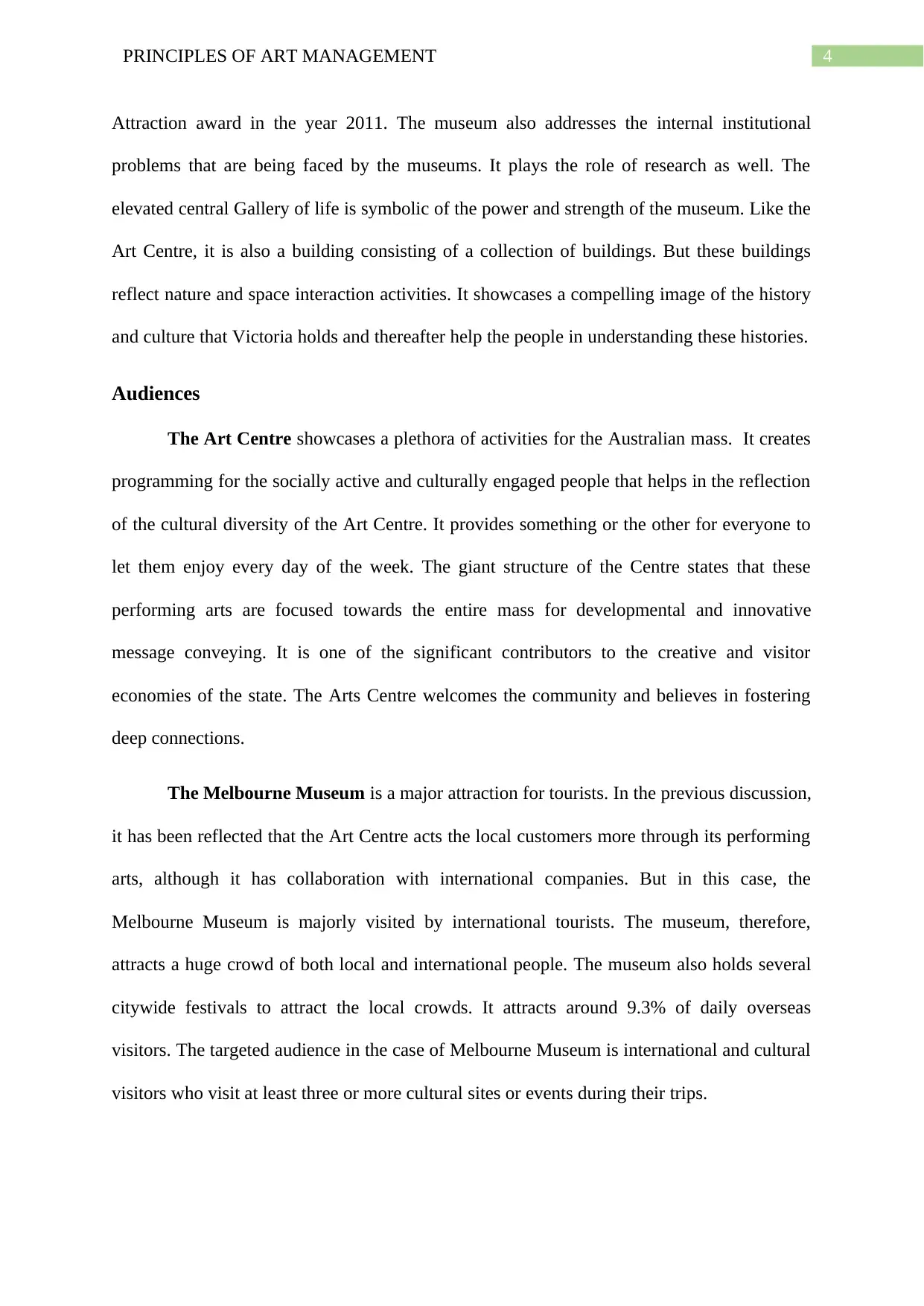
4PRINCIPLES OF ART MANAGEMENT
Attraction award in the year 2011. The museum also addresses the internal institutional
problems that are being faced by the museums. It plays the role of research as well. The
elevated central Gallery of life is symbolic of the power and strength of the museum. Like the
Art Centre, it is also a building consisting of a collection of buildings. But these buildings
reflect nature and space interaction activities. It showcases a compelling image of the history
and culture that Victoria holds and thereafter help the people in understanding these histories.
Audiences
The Art Centre showcases a plethora of activities for the Australian mass. It creates
programming for the socially active and culturally engaged people that helps in the reflection
of the cultural diversity of the Art Centre. It provides something or the other for everyone to
let them enjoy every day of the week. The giant structure of the Centre states that these
performing arts are focused towards the entire mass for developmental and innovative
message conveying. It is one of the significant contributors to the creative and visitor
economies of the state. The Arts Centre welcomes the community and believes in fostering
deep connections.
The Melbourne Museum is a major attraction for tourists. In the previous discussion,
it has been reflected that the Art Centre acts the local customers more through its performing
arts, although it has collaboration with international companies. But in this case, the
Melbourne Museum is majorly visited by international tourists. The museum, therefore,
attracts a huge crowd of both local and international people. The museum also holds several
citywide festivals to attract the local crowds. It attracts around 9.3% of daily overseas
visitors. The targeted audience in the case of Melbourne Museum is international and cultural
visitors who visit at least three or more cultural sites or events during their trips.
Attraction award in the year 2011. The museum also addresses the internal institutional
problems that are being faced by the museums. It plays the role of research as well. The
elevated central Gallery of life is symbolic of the power and strength of the museum. Like the
Art Centre, it is also a building consisting of a collection of buildings. But these buildings
reflect nature and space interaction activities. It showcases a compelling image of the history
and culture that Victoria holds and thereafter help the people in understanding these histories.
Audiences
The Art Centre showcases a plethora of activities for the Australian mass. It creates
programming for the socially active and culturally engaged people that helps in the reflection
of the cultural diversity of the Art Centre. It provides something or the other for everyone to
let them enjoy every day of the week. The giant structure of the Centre states that these
performing arts are focused towards the entire mass for developmental and innovative
message conveying. It is one of the significant contributors to the creative and visitor
economies of the state. The Arts Centre welcomes the community and believes in fostering
deep connections.
The Melbourne Museum is a major attraction for tourists. In the previous discussion,
it has been reflected that the Art Centre acts the local customers more through its performing
arts, although it has collaboration with international companies. But in this case, the
Melbourne Museum is majorly visited by international tourists. The museum, therefore,
attracts a huge crowd of both local and international people. The museum also holds several
citywide festivals to attract the local crowds. It attracts around 9.3% of daily overseas
visitors. The targeted audience in the case of Melbourne Museum is international and cultural
visitors who visit at least three or more cultural sites or events during their trips.
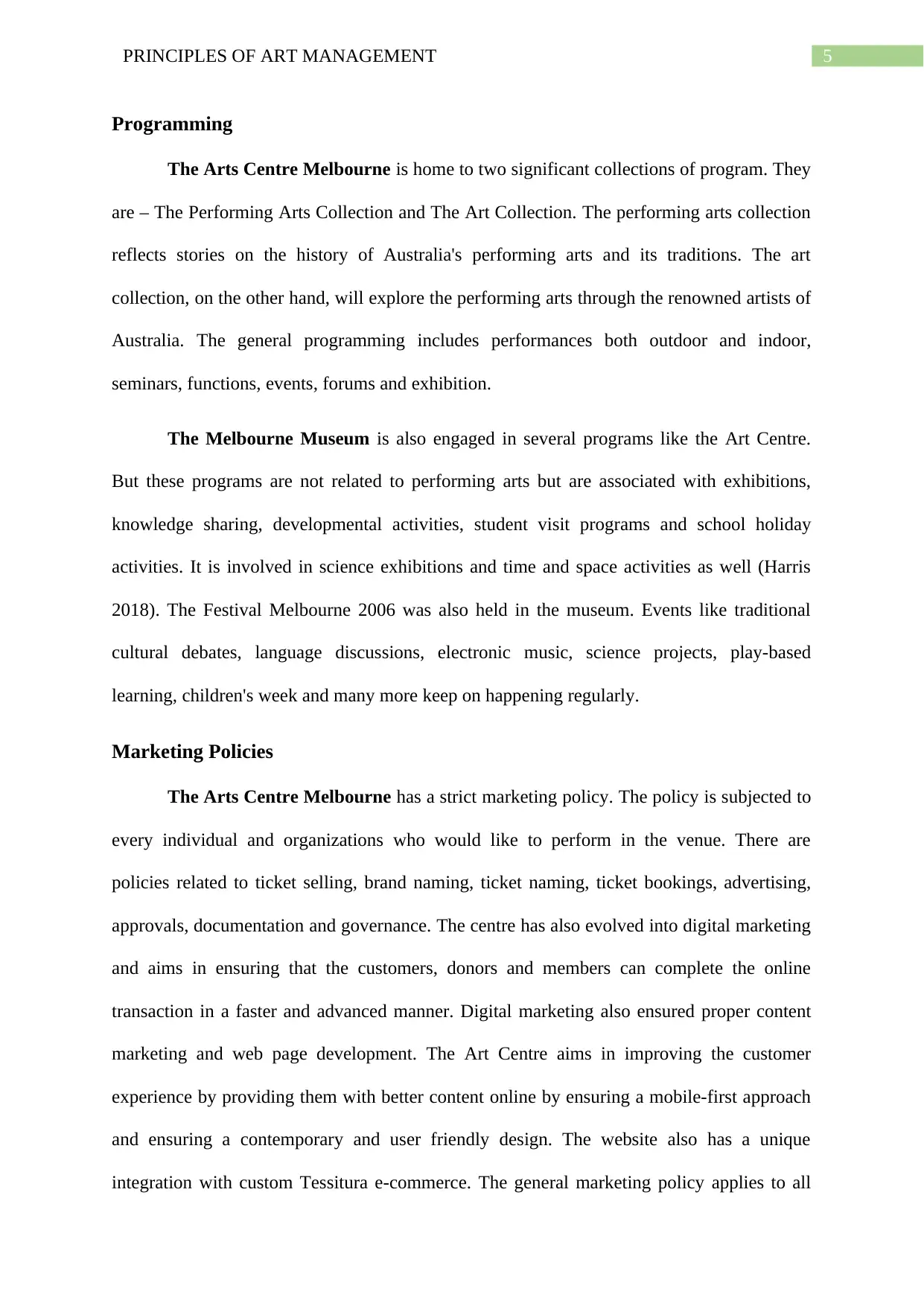
5PRINCIPLES OF ART MANAGEMENT
Programming
The Arts Centre Melbourne is home to two significant collections of program. They
are – The Performing Arts Collection and The Art Collection. The performing arts collection
reflects stories on the history of Australia's performing arts and its traditions. The art
collection, on the other hand, will explore the performing arts through the renowned artists of
Australia. The general programming includes performances both outdoor and indoor,
seminars, functions, events, forums and exhibition.
The Melbourne Museum is also engaged in several programs like the Art Centre.
But these programs are not related to performing arts but are associated with exhibitions,
knowledge sharing, developmental activities, student visit programs and school holiday
activities. It is involved in science exhibitions and time and space activities as well (Harris
2018). The Festival Melbourne 2006 was also held in the museum. Events like traditional
cultural debates, language discussions, electronic music, science projects, play-based
learning, children's week and many more keep on happening regularly.
Marketing Policies
The Arts Centre Melbourne has a strict marketing policy. The policy is subjected to
every individual and organizations who would like to perform in the venue. There are
policies related to ticket selling, brand naming, ticket naming, ticket bookings, advertising,
approvals, documentation and governance. The centre has also evolved into digital marketing
and aims in ensuring that the customers, donors and members can complete the online
transaction in a faster and advanced manner. Digital marketing also ensured proper content
marketing and web page development. The Art Centre aims in improving the customer
experience by providing them with better content online by ensuring a mobile-first approach
and ensuring a contemporary and user friendly design. The website also has a unique
integration with custom Tessitura e-commerce. The general marketing policy applies to all
Programming
The Arts Centre Melbourne is home to two significant collections of program. They
are – The Performing Arts Collection and The Art Collection. The performing arts collection
reflects stories on the history of Australia's performing arts and its traditions. The art
collection, on the other hand, will explore the performing arts through the renowned artists of
Australia. The general programming includes performances both outdoor and indoor,
seminars, functions, events, forums and exhibition.
The Melbourne Museum is also engaged in several programs like the Art Centre.
But these programs are not related to performing arts but are associated with exhibitions,
knowledge sharing, developmental activities, student visit programs and school holiday
activities. It is involved in science exhibitions and time and space activities as well (Harris
2018). The Festival Melbourne 2006 was also held in the museum. Events like traditional
cultural debates, language discussions, electronic music, science projects, play-based
learning, children's week and many more keep on happening regularly.
Marketing Policies
The Arts Centre Melbourne has a strict marketing policy. The policy is subjected to
every individual and organizations who would like to perform in the venue. There are
policies related to ticket selling, brand naming, ticket naming, ticket bookings, advertising,
approvals, documentation and governance. The centre has also evolved into digital marketing
and aims in ensuring that the customers, donors and members can complete the online
transaction in a faster and advanced manner. Digital marketing also ensured proper content
marketing and web page development. The Art Centre aims in improving the customer
experience by providing them with better content online by ensuring a mobile-first approach
and ensuring a contemporary and user friendly design. The website also has a unique
integration with custom Tessitura e-commerce. The general marketing policy applies to all
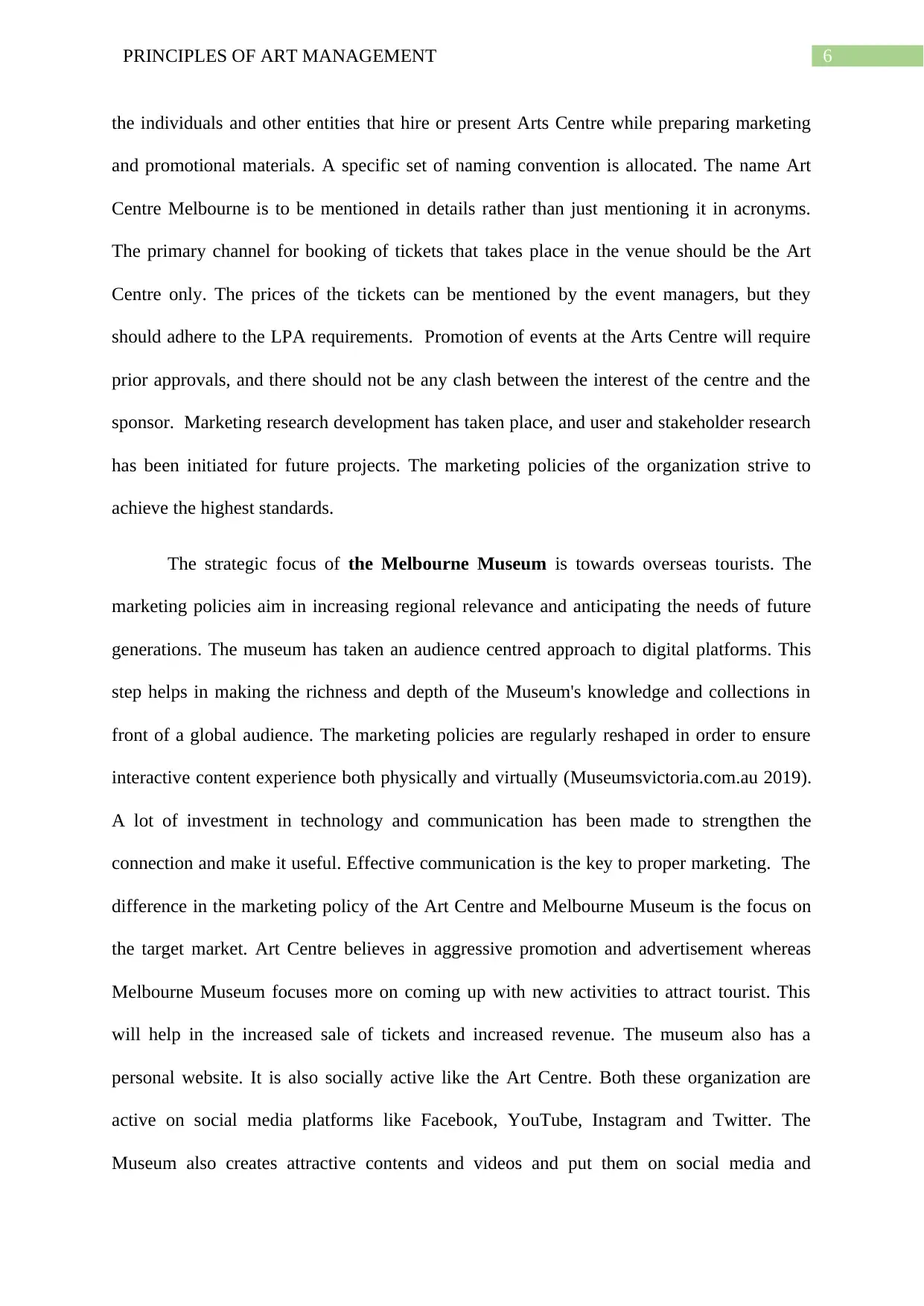
6PRINCIPLES OF ART MANAGEMENT
the individuals and other entities that hire or present Arts Centre while preparing marketing
and promotional materials. A specific set of naming convention is allocated. The name Art
Centre Melbourne is to be mentioned in details rather than just mentioning it in acronyms.
The primary channel for booking of tickets that takes place in the venue should be the Art
Centre only. The prices of the tickets can be mentioned by the event managers, but they
should adhere to the LPA requirements. Promotion of events at the Arts Centre will require
prior approvals, and there should not be any clash between the interest of the centre and the
sponsor. Marketing research development has taken place, and user and stakeholder research
has been initiated for future projects. The marketing policies of the organization strive to
achieve the highest standards.
The strategic focus of the Melbourne Museum is towards overseas tourists. The
marketing policies aim in increasing regional relevance and anticipating the needs of future
generations. The museum has taken an audience centred approach to digital platforms. This
step helps in making the richness and depth of the Museum's knowledge and collections in
front of a global audience. The marketing policies are regularly reshaped in order to ensure
interactive content experience both physically and virtually (Museumsvictoria.com.au 2019).
A lot of investment in technology and communication has been made to strengthen the
connection and make it useful. Effective communication is the key to proper marketing. The
difference in the marketing policy of the Art Centre and Melbourne Museum is the focus on
the target market. Art Centre believes in aggressive promotion and advertisement whereas
Melbourne Museum focuses more on coming up with new activities to attract tourist. This
will help in the increased sale of tickets and increased revenue. The museum also has a
personal website. It is also socially active like the Art Centre. Both these organization are
active on social media platforms like Facebook, YouTube, Instagram and Twitter. The
Museum also creates attractive contents and videos and put them on social media and
the individuals and other entities that hire or present Arts Centre while preparing marketing
and promotional materials. A specific set of naming convention is allocated. The name Art
Centre Melbourne is to be mentioned in details rather than just mentioning it in acronyms.
The primary channel for booking of tickets that takes place in the venue should be the Art
Centre only. The prices of the tickets can be mentioned by the event managers, but they
should adhere to the LPA requirements. Promotion of events at the Arts Centre will require
prior approvals, and there should not be any clash between the interest of the centre and the
sponsor. Marketing research development has taken place, and user and stakeholder research
has been initiated for future projects. The marketing policies of the organization strive to
achieve the highest standards.
The strategic focus of the Melbourne Museum is towards overseas tourists. The
marketing policies aim in increasing regional relevance and anticipating the needs of future
generations. The museum has taken an audience centred approach to digital platforms. This
step helps in making the richness and depth of the Museum's knowledge and collections in
front of a global audience. The marketing policies are regularly reshaped in order to ensure
interactive content experience both physically and virtually (Museumsvictoria.com.au 2019).
A lot of investment in technology and communication has been made to strengthen the
connection and make it useful. Effective communication is the key to proper marketing. The
difference in the marketing policy of the Art Centre and Melbourne Museum is the focus on
the target market. Art Centre believes in aggressive promotion and advertisement whereas
Melbourne Museum focuses more on coming up with new activities to attract tourist. This
will help in the increased sale of tickets and increased revenue. The museum also has a
personal website. It is also socially active like the Art Centre. Both these organization are
active on social media platforms like Facebook, YouTube, Instagram and Twitter. The
Museum also creates attractive contents and videos and put them on social media and
Paraphrase This Document
Need a fresh take? Get an instant paraphrase of this document with our AI Paraphraser
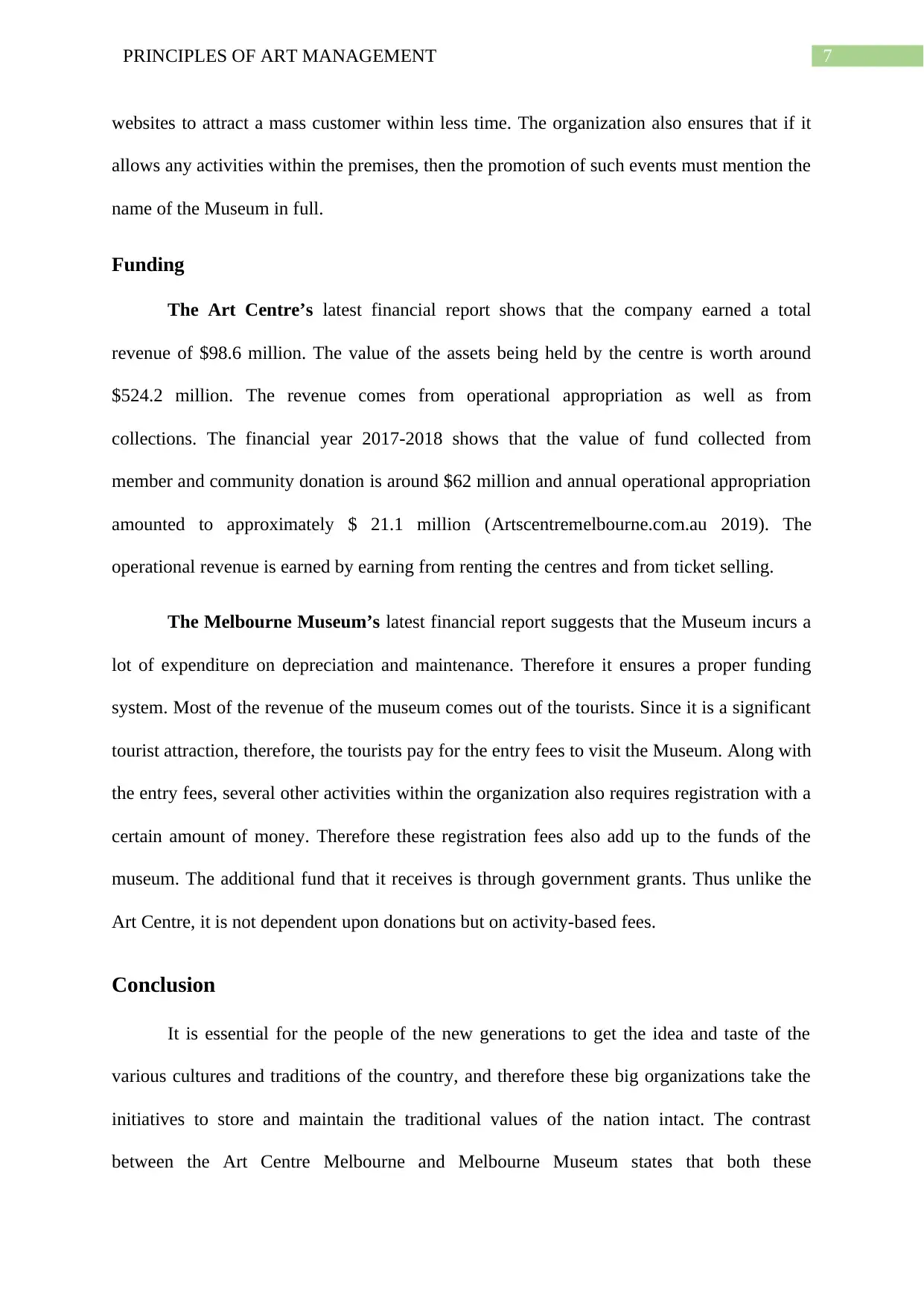
7PRINCIPLES OF ART MANAGEMENT
websites to attract a mass customer within less time. The organization also ensures that if it
allows any activities within the premises, then the promotion of such events must mention the
name of the Museum in full.
Funding
The Art Centre’s latest financial report shows that the company earned a total
revenue of $98.6 million. The value of the assets being held by the centre is worth around
$524.2 million. The revenue comes from operational appropriation as well as from
collections. The financial year 2017-2018 shows that the value of fund collected from
member and community donation is around $62 million and annual operational appropriation
amounted to approximately $ 21.1 million (Artscentremelbourne.com.au 2019). The
operational revenue is earned by earning from renting the centres and from ticket selling.
The Melbourne Museum’s latest financial report suggests that the Museum incurs a
lot of expenditure on depreciation and maintenance. Therefore it ensures a proper funding
system. Most of the revenue of the museum comes out of the tourists. Since it is a significant
tourist attraction, therefore, the tourists pay for the entry fees to visit the Museum. Along with
the entry fees, several other activities within the organization also requires registration with a
certain amount of money. Therefore these registration fees also add up to the funds of the
museum. The additional fund that it receives is through government grants. Thus unlike the
Art Centre, it is not dependent upon donations but on activity-based fees.
Conclusion
It is essential for the people of the new generations to get the idea and taste of the
various cultures and traditions of the country, and therefore these big organizations take the
initiatives to store and maintain the traditional values of the nation intact. The contrast
between the Art Centre Melbourne and Melbourne Museum states that both these
websites to attract a mass customer within less time. The organization also ensures that if it
allows any activities within the premises, then the promotion of such events must mention the
name of the Museum in full.
Funding
The Art Centre’s latest financial report shows that the company earned a total
revenue of $98.6 million. The value of the assets being held by the centre is worth around
$524.2 million. The revenue comes from operational appropriation as well as from
collections. The financial year 2017-2018 shows that the value of fund collected from
member and community donation is around $62 million and annual operational appropriation
amounted to approximately $ 21.1 million (Artscentremelbourne.com.au 2019). The
operational revenue is earned by earning from renting the centres and from ticket selling.
The Melbourne Museum’s latest financial report suggests that the Museum incurs a
lot of expenditure on depreciation and maintenance. Therefore it ensures a proper funding
system. Most of the revenue of the museum comes out of the tourists. Since it is a significant
tourist attraction, therefore, the tourists pay for the entry fees to visit the Museum. Along with
the entry fees, several other activities within the organization also requires registration with a
certain amount of money. Therefore these registration fees also add up to the funds of the
museum. The additional fund that it receives is through government grants. Thus unlike the
Art Centre, it is not dependent upon donations but on activity-based fees.
Conclusion
It is essential for the people of the new generations to get the idea and taste of the
various cultures and traditions of the country, and therefore these big organizations take the
initiatives to store and maintain the traditional values of the nation intact. The contrast
between the Art Centre Melbourne and Melbourne Museum states that both these
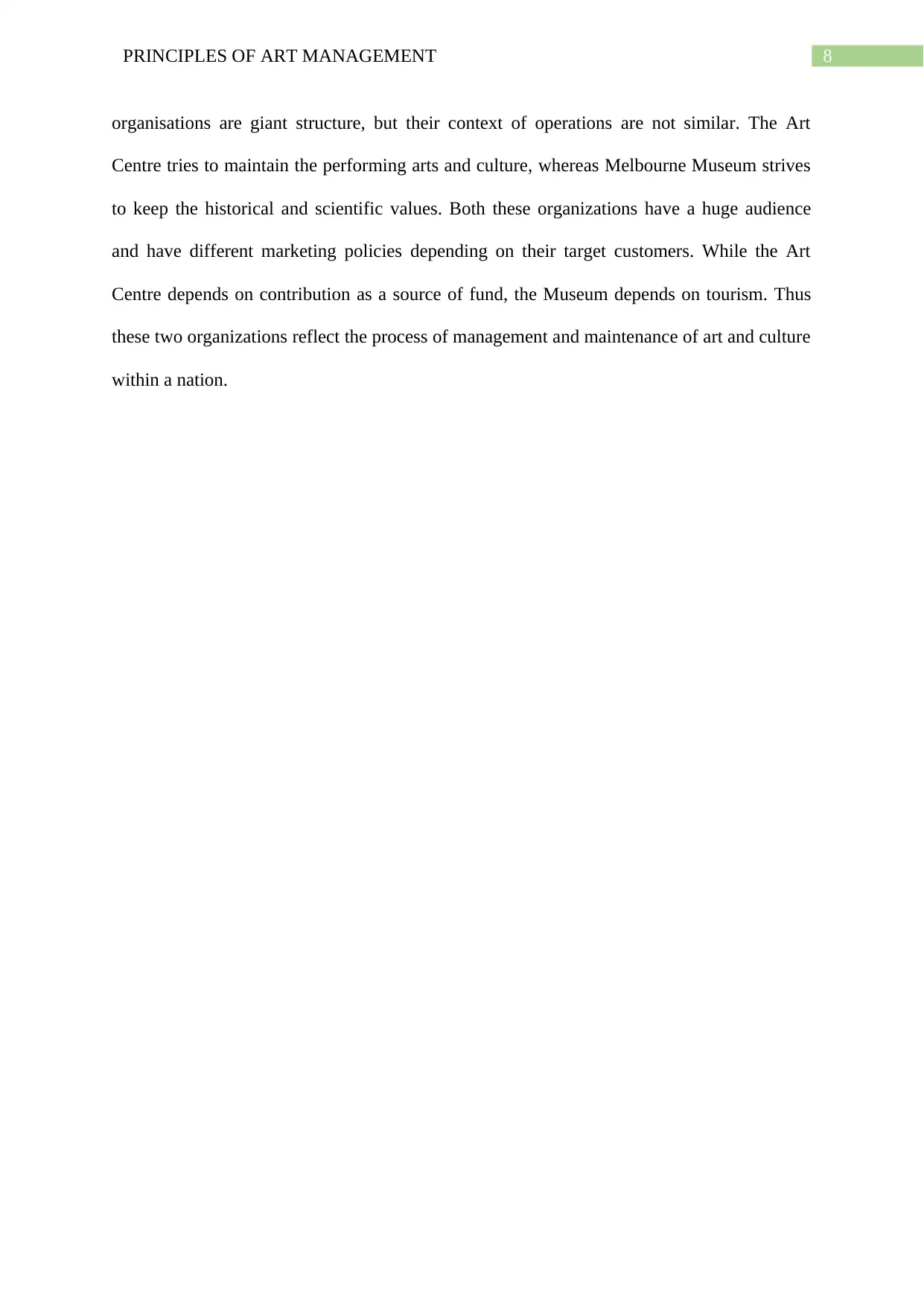
8PRINCIPLES OF ART MANAGEMENT
organisations are giant structure, but their context of operations are not similar. The Art
Centre tries to maintain the performing arts and culture, whereas Melbourne Museum strives
to keep the historical and scientific values. Both these organizations have a huge audience
and have different marketing policies depending on their target customers. While the Art
Centre depends on contribution as a source of fund, the Museum depends on tourism. Thus
these two organizations reflect the process of management and maintenance of art and culture
within a nation.
organisations are giant structure, but their context of operations are not similar. The Art
Centre tries to maintain the performing arts and culture, whereas Melbourne Museum strives
to keep the historical and scientific values. Both these organizations have a huge audience
and have different marketing policies depending on their target customers. While the Art
Centre depends on contribution as a source of fund, the Museum depends on tourism. Thus
these two organizations reflect the process of management and maintenance of art and culture
within a nation.
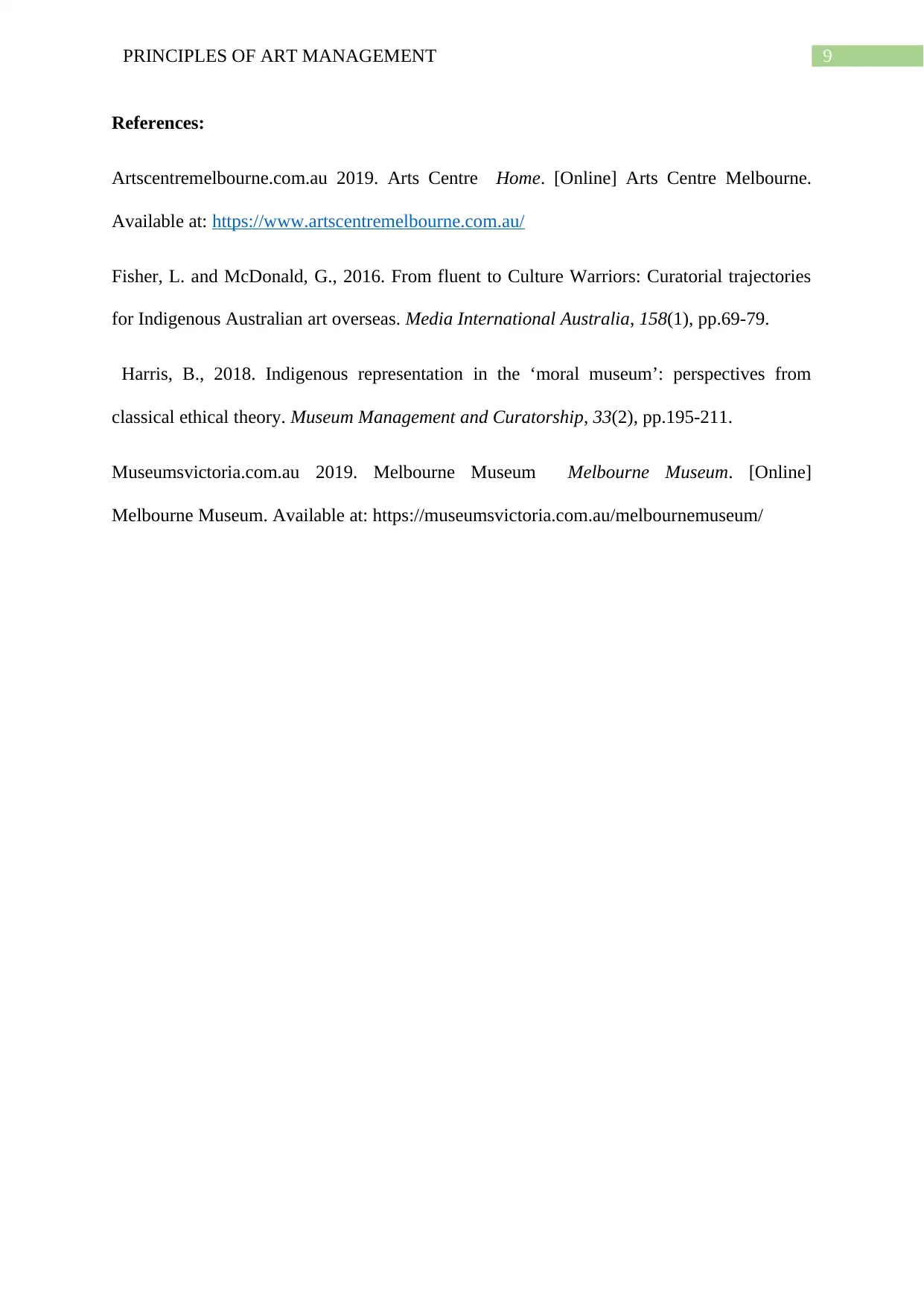
9PRINCIPLES OF ART MANAGEMENT
References:
Artscentremelbourne.com.au 2019. Arts Centre Home. [Online] Arts Centre Melbourne.
Available at: https://www.artscentremelbourne.com.au/
Fisher, L. and McDonald, G., 2016. From fluent to Culture Warriors: Curatorial trajectories
for Indigenous Australian art overseas. Media International Australia, 158(1), pp.69-79.
Harris, B., 2018. Indigenous representation in the ‘moral museum’: perspectives from
classical ethical theory. Museum Management and Curatorship, 33(2), pp.195-211.
Museumsvictoria.com.au 2019. Melbourne Museum Melbourne Museum. [Online]
Melbourne Museum. Available at: https://museumsvictoria.com.au/melbournemuseum/
References:
Artscentremelbourne.com.au 2019. Arts Centre Home. [Online] Arts Centre Melbourne.
Available at: https://www.artscentremelbourne.com.au/
Fisher, L. and McDonald, G., 2016. From fluent to Culture Warriors: Curatorial trajectories
for Indigenous Australian art overseas. Media International Australia, 158(1), pp.69-79.
Harris, B., 2018. Indigenous representation in the ‘moral museum’: perspectives from
classical ethical theory. Museum Management and Curatorship, 33(2), pp.195-211.
Museumsvictoria.com.au 2019. Melbourne Museum Melbourne Museum. [Online]
Melbourne Museum. Available at: https://museumsvictoria.com.au/melbournemuseum/
1 out of 10
Related Documents
Your All-in-One AI-Powered Toolkit for Academic Success.
+13062052269
info@desklib.com
Available 24*7 on WhatsApp / Email
![[object Object]](/_next/static/media/star-bottom.7253800d.svg)
Unlock your academic potential
© 2024 | Zucol Services PVT LTD | All rights reserved.




